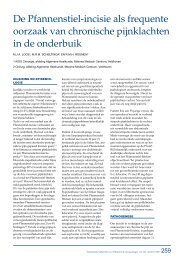Surgical management of chronic inguinal pain syndromes - Liespijn
Surgical management of chronic inguinal pain syndromes - Liespijn
Surgical management of chronic inguinal pain syndromes - Liespijn
You also want an ePaper? Increase the reach of your titles
YUMPU automatically turns print PDFs into web optimized ePapers that Google loves.
INTRODUCTIONWorldwide groin hernia repair is one <strong>of</strong> the most common operations performed ingeneral surgery, with any complication affecting a high number <strong>of</strong> patients. Since theintroduction <strong>of</strong> the ‘tension-free mesh technique’ by Lichtenstein in 1970, recurrencerates have diminished to an acceptable level. Low recurrence rates have shifted attentiontowards <strong>chronic</strong> <strong>pain</strong> and functional impairments. With a reported incidencevarying from 14 to 54%, several studies have shown <strong>chronic</strong> <strong>pain</strong> to be a common sequelafter groin hernia repair 1-11 . As a result about 11% <strong>of</strong> the patients is claimed to be functionallyimpaired in their work or leisure activities 1 . Causative mechanisms are thoughtto be neuropathic (entrapment or injury <strong>of</strong> ilio<strong>inguinal</strong>, iliohypogastric or genit<strong>of</strong>emoralnerves) or somatic (tissue damage, scar formation) 14 . In the present study we evaluatethe results and complaints <strong>of</strong> a large group <strong>of</strong> patients after elective groin hernia repairperformed mainly by residents in two teaching hospitals.PATIENTS AND METHODS<strong>chronic</strong> <strong>pain</strong> was defined as any VAS>0. After two months all non-responders werereminded by telephone or by post.Statistical analysis was carried out using Statistical Package for the Social Sciences (SPSS)for Windows version 12.0.1. The level <strong>of</strong> significance was set at a p-value <strong>of</strong> 0.05. Pearsonχ2–test was used to determine statistical significance between different variables andthe presence <strong>of</strong> <strong>pain</strong>.RESULTSA total <strong>of</strong> 2339 elective groin hernia repairs was performed on adult patients betweenJanuary 2000 and August 2005 in the Máxima Medical Center in Eindhoven (n=973)and in Veldhoven (n=1368). Since the operation 82 patients were deceased and 75patients had moved. Another 18 patients were excluded because <strong>of</strong> mental incapacitation,leaving 2164 patients. The questionnaire was returned by 1766 patients (MMC-En=702, MMC-V n=1064) resulting in a response rate <strong>of</strong> 81.6% (Figure 1).This is a population based postal questionnaire study <strong>of</strong> consecutive adult patients(≥ 18 years) who underwent groin hernia repair between January 2000 and August 2005in two teaching hospitals (the Máxima Medical Center in Eindhoven (MMC-E) and Veldhoven(MMC-V), The Netherlands, serving a total population <strong>of</strong> approximately 350.000inhabitants). Patient records were checked to exclude patients who were deceased orunable to return the questionnaire because <strong>of</strong> mental incapacities. If patients hadmoved and no current address was available, they were excluded as well. The differentsurgical techniques that were used were both open (Lichtenstein, Shouldice) and laparoscopicrepair (Total Extra Peritoneal = TEP, Trans Abdominal Pre Peritoneal = TAPP) forprimary or recurrent and uni- or bilateral groin hernias.To assure that the ‘The International Association for the Study <strong>of</strong> Pain definition’ <strong>of</strong><strong>chronic</strong> <strong>pain</strong> (<strong>pain</strong> persisting beyond the normal tissue healing time <strong>of</strong> 3 months) wasapplicable to all reported <strong>pain</strong> complaints, the shortest follow-up period comprisedthree months 12 . The questionnaire was based on information from various previousstudies 1-11 (See appendix). Between November 2005 and February 2006 all patients <strong>of</strong> theMáxima Medical Center were sent a questionnaire with a pre-stamped envelope withquestions regarding frequency and intensity <strong>of</strong> <strong>pain</strong>, suspicion <strong>of</strong> recurrence, presence<strong>of</strong> numbness and degree <strong>of</strong> functional impairment in work or leisure activities. Painintensity was measured with a Visual Analogue scale (VAS). This is a 10 cm scale with onthe one end ‘no <strong>pain</strong>’ and on the other ‘unbearable <strong>pain</strong>’. In order to evaluate differentseverities it was subdivided according to a previously validated classification: 0 = no<strong>pain</strong>, 7 = severe <strong>pain</strong> 13 . In the present study,2339 adult patientswith groinhernia repair2164 patientseligible(100%)Response rate:1766 patients(81.6%)Excluded patients:- Deceased (n=82)- Unobtainable address (n=75)- Mentally incapacitated (n=18)Figure 1 Patient flow and response to the questionnaire.20 Chapter 2Chronic sequelae <strong>of</strong> common elective groin hernia repair 21





